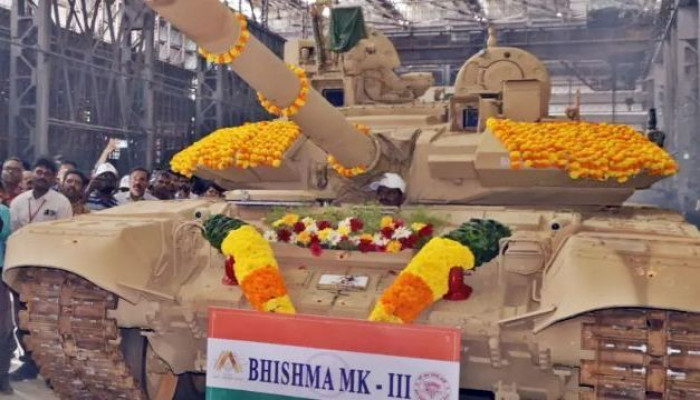First advanced T-90 Mark-III delivered to Indian Army by Heavy Vehicles Factory, Avadi
- In Reports
- 09:59 PM, May 27, 2024
- Myind Staff
The Indian Army has received the first batch of upgraded T-90 Mark-III tanks, known domestically as the Bhishma Mark-III, produced by the Heavy Vehicles Factory.
Indian sources indicate that modernisation involves incorporating new technologies and systems into the tank to enhance the combat capabilities of the existing fleet. New Delhi intends to modernise a total of 300 T-90 tanks.
According to Indian sources, a key focus in upgrading the T-90 Bhishma Mark-III has been the incorporation of domestically produced systems. India has long pursued its "Make in India" initiative, particularly within the defence sector. This approach has compelled Russian and Western manufacturers, including those from the United States, to develop their technological expertise within Indian borders.
The Bhishma Mark-III tank is an advanced variant of the T-90, a third-generation Russian main battle tank originally developed by Uralvagonzavod. Specifically tailored for the Indian Army, the Bhishma Mark-III incorporates numerous enhancements and adaptations to address the distinct operational demands and environmental challenges faced by Indian forces.
The T-90 Mark-III has seen a notable increase in firepower, largely attributed to its upgraded fire control systems. This includes a digital ballistic computer, which streamlines aiming and gun control processes, contributing significantly to the tank's enhanced capabilities.
A Correction Input Device (CID), which automatically records and corrects for tank gun barrel wear, works seamlessly with this ballistic computer. The Main Battle Tank (MBT) now sports a commander’s infrared sight with an LCD display and a muzzle reference system (MRS) for better accuracy.
Among the most impressive upgrades is the inclusion of digital communications capabilities, enhancing communication between crew members and units on the battlefield. Additionally, the tank has been equipped with an anti-thermal coating, which reduces its visibility in the infrared spectrum, thus enhancing its stealth capabilities and making it more challenging to detect.
A key difference between the Bhishma Mark-III and the original T-90 lies in the enhanced armour protection. The Bhishma Mark-III features upgraded composite armour and advanced Explosive Reactive Armour (ERA), offering superior defence against modern anti-tank munitions.
Another major difference is the inclusion of an improved engine in the Bhishma Mark-III. This tank is now powered by a more robust and reliable engine, providing enhanced mobility and combat range. Such an upgrade ensures that the Bhishma Mark-III can manoeuvre more effectively across diverse terrains, ranging from deserts to mountainous regions.
In terms of armament, the Bhishma Mark-III retains the 125mm smoothbore gun of the original T-90 but includes improved ammunition types and an automatic loading system. This facilitates quicker reloading and a heightened rate of fire, rendering the tank more formidable in combat situations. Furthermore, the Bhishma Mark-III is outfitted with advanced anti-tank guided missiles (ATGMs), enabling extended-range combat operations.
Initially, India's strategy involved active participation from Russia in upgrading the indigenous fleet of T-90 tanks. These plans were established even before the outbreak of the conflict between Russia and Ukraine in 2022. By the end of 2021, a batch of T-90 Bhishma tanks was dispatched to Uralvagonzavod to undergo a segment of the modernisation process.
The conflict strained the Russian defence industry, prioritising resources for domestic needs and causing Indian tank upgrades to be sidelined. There were even reports of Russian use of Indian T-90s in Ukraine, prompting a meeting between Putin and Modi. Modi reassured journalists of preserved relations with Russia, stating, "there are no unsolvable problems."
During this period, it's plausible that such a decision was made: Russia would retain the Indian T-90s without pressure to return them, in exchange for providing improved licensing agreements to New Delhi. It echoes the rationale behind the Indian factory's upgrade to the Mark III. However, this remains unconfirmed as reliable information at present.
Image source: Top War







Comments